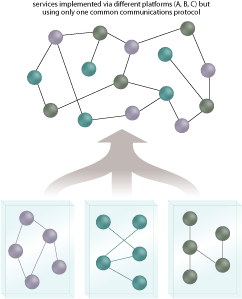CSC/ECE 517 Fall 2009/wiki2 16 rs: Difference between revisions
| Line 38: | Line 38: | ||
[http://www.soapatterns.org/masterlist_c.asp Foundational Inventory Patterns] | [http://www.soapatterns.org/masterlist_c.asp Foundational Inventory Patterns] | ||
Logical Inventory Layer Patterns | [http://www.soapatterns.org/masterlist_c.asp Logical Inventory Layer Patterns] | ||
Inventory Centralization Patterns | [http://www.soapatterns.org/masterlist_c.asp Inventory Centralization Patterns] | ||
Inventory Implementation Patterns | [http://www.soapatterns.org/masterlist_c.asp Inventory Implementation Patterns] | ||
Inventory Governance Patterns | [http://www.soapatterns.org/masterlist_c.asp Inventory Governance Patterns] | ||
Foundational Service Patterns | [http://www.soapatterns.org/masterlist_c.asp Foundational Service Patterns] | ||
Service Implementation Patterns | [http://www.soapatterns.org/masterlist_c.asp Service Implementation Patterns] | ||
Service Security Patterns | [http://www.soapatterns.org/masterlist_c.asp Service Security Patterns] | ||
Service Contract Design Patterns | [http://www.soapatterns.org/masterlist_c.asp Service Contract Design Patterns] | ||
Legacy Encapsulation Patterns | [http://www.soapatterns.org/masterlist_c.asp Legacy Encapsulation Patterns] | ||
Service Governance Patterns | [http://www.soapatterns.org/masterlist_c.asp Service Governance Patterns] | ||
Capability Composition Patterns | [http://www.soapatterns.org/masterlist_c.asp Capability Composition Patterns] | ||
Service Messaging Patterns | [http://www.soapatterns.org/masterlist_c.asp Service Messaging Patterns] | ||
Composition Implementation Patterns | [http://www.soapatterns.org/masterlist_c.asp Composition Implementation Patterns] | ||
Service Interaction Security Patterns | [http://www.soapatterns.org/masterlist_c.asp Service Interaction Security Patterns] | ||
Transformation Patterns | [http://www.soapatterns.org/masterlist_c.asp Transformation Patterns] | ||
Common Compound Design Patterns | [http://www.soapatterns.org/masterlist_c.asp Common Compound Design Patterns] | ||
=Example Design Patterns = | =Example Design Patterns = | ||
Revision as of 03:46, 9 October 2009
CSC/ECE 517 Fall 2009/wiki2 16 rs
SOA provides another view of providing functionality based upon services offered in terms of protocols and a specific API. Research and report on what patterns have been proposed and are utilized within this domain. How do they differ from traditional design patterns proposed by Eric Gamma, Richard Helm, Ralph Johnson, and John Vlissides? How are they similar?
Introduction
SOA provides another view of providing functionality based upon services offered in terms of protocols and a specific API. Research and report on what patterns have been proposed and are utilized within this domain. How do they differ from traditional design patterns proposed by Eric Gamma, Richard Helm, Ralph Johnson, and John Vlissides? How are they similar?
This page reviews the different service oriented architecture patterns proposed for protocols and compares them them with the corresponding patterns which were proposed for object oriented reuse.
Service Oriented Architecture-An Overview
SOA-Definition
A service-oriented architecture is essentially a collection of services. These services communicate with each other.The communication can involve either simple data passing or it could involve two or more services coordinating some activity. Some means of connecting services to each other is needed.Rather than defining an API, SOA defines the interface in terms of protocols and functionality. An endpoint is the entry point to such an SOA implementation.Service-orientation requires loose coupling of services with operating systems, and other technologies that underlie applications. SOA separates functions into distinct units, or services, which developers make accessible over a network in order to allow users to combine and reuse them in the production of applications. These services communicate with each other by passing data from one service to another, or by coordinating an activity between two or more services.
Why SOA?
Vast majority of Businesses working in the field of Information Technology have to justify their projects with a return on their investments. This puts Information Technology, as a field under enormous pressure. Information Technology must boast requirements that are increasingly responsive and flexible to the shifting needs of different Businesses.
Firms dealing with Information Technology must also be able to face the challenge of taking on an array of software systems that may or may not be compatible with one another. Moreover, Information Technology has to face demands to bring new commercial services to a much wider array of customers. Customers may access services through web interfaces, or may be part of a supply chain that needs to decrease the time and cost of manufacturing.
Thus, Information Technology companies are always on the look out for solutions that will help them meet the above demands – without having to spend a lot of money.SOA offers a solution to satisfy the above needs of the industry
SOA-Benifits
In architectural terms, a modern architectural design should be Service Oriented, loosely coupled, driven by events, able to support both integration and assembly, aligned with valuable life cycle support processes, and able to leverage existing infrastructure and applications.
When it comes to Service Oriented Architecture, it tends to offer a variety of different advantages over more traditional methods of distributing computing. These include offering business services across several platforms; providing location independence; providing authentication as well as authorization support on ever tier; a loosely coupled approach; and dynamic search and connectivity to other services. At the same time, it allows that services do not have to be located on a particular system or network.
Design Patterns in SOA
A design pattern is a general reusable solution to a commonly occurring problem in software design. A design pattern is not a finished design that can be transformed directly into code. It is a description or template for how to solve a problem that can be used in many different situations.Design patterns typically show relationships and interactions between classes or objects, without specifying the final application classes or objects that are involved.
Design Patterns proposed
The proposed Design Patterns for SOA fall in to following categories.They are listed below and corresponding patterns in each category are given.
Foundational Inventory Patterns Logical Inventory Layer Patterns Inventory Centralization Patterns Inventory Implementation Patterns Inventory Governance Patterns Foundational Service Patterns Service Implementation Patterns Service Security Patterns Service Contract Design Patterns Legacy Encapsulation Patterns Service Governance Patterns Capability Composition Patterns Service Messaging Patterns Composition Implementation Patterns Service Interaction Security Patterns Transformation Patterns Common Compound Design Patterns
